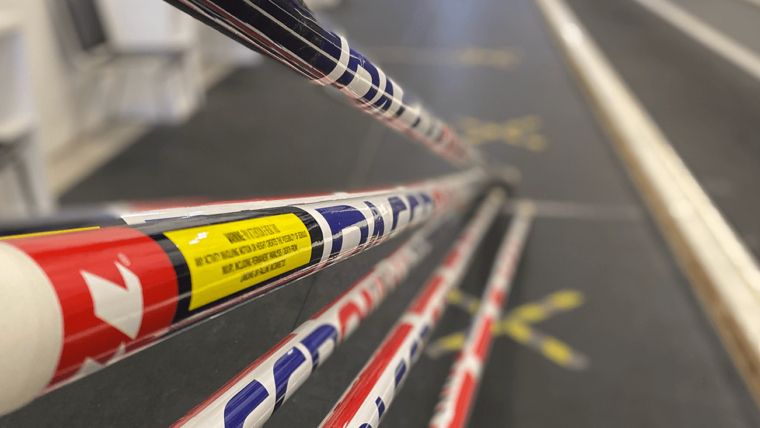So…Sometimes pole vaulting can be frustrating. Did you know that? Of course you did. Well, having grown up and pole vaulted in the wonderful (insert sarcastic grin) Illinois spring weather conditions, we know that vaulting outdoors in March, April, and May can accelerate this frustration. One strategy we have used throughout the years is playing pole vaulting GAMES!!!! This is a great way to reduce stress, accept conditions, adjust to conditions, get a fresh perspective, and even have fun vaulting in a 37 degree head wind with snow hitting you in the eyeballs….
Disclaimer: Play these games at your own risk! We do not recommend these games to coaches who are inexperienced. There may be advanced adjustments that need to be made in an athlete’s grip, pole size, and approach length for these games to be played safely. These games should be done with modest grips and poles. If you try to do these games with bi grips and big poles, you could end up hurt, or putting the “nail in the coffin” of your remaining confidence, which completely flies in the face of the reason we are implementing these games in the first place.
10 in a Row
Objective: The vaulter’s objective is to clear ten consecutive bars, with the bungee set a foot and a half to two feet below their personal best.
How to Play: Vaulters usually run from a shorter approach during this game. A short approach is not required, but it is recommended. The standards must remain at the deepest setting. A bungee is used during this game. If the vaulter or his/her pole touches the bungee it is considered a miss. If the vaulter runs up and stops in a vault attempt, it is a miss. If the vaulter misses a bungee, they must return from their present total of vaults to zero, and start over. Whoever reaches ten in a row first, is the winner of the game. It is best to have a time limit on this game. Whoever has the highest total of clearances at the end of the time limit wins.
Benefits: This game promotes consistency and proper focus on technical process regardless of conditions for individual vaulters. As athletes get closer to ten in a row, the vaulter feels more pressure, and this is a good time to work on staying focused when the pressure is on. It is also a way to develop a rhythm with consistent clearances of a bungee. Even with the lower setting of the bungee, athletes will gain a small amount of confidence every time they have a “no touch” clearance.
Team 10 in a Row
Objective: The objective is for a team of vaulters to clear ten consecutive bars.
How to play: The same rules apply as in “Ten in a Row”, but each vaulter is contributing to the tally of consecutive clearances for the team. The bar is still set a foot and a half to two feet below each vaulters PR and if anything touches the bar (yes your shorts count) the teams total goes back to zero and they start over. So, athlete #1 goes and clears…team total is one. Athlete #2 goes and clears…team total is two. Athlete #3 goes and misses…team total goes back to zero. You can do this as a whole team and work towards the goal together, or if your vault squad is big enough, you can split into two teams and see which one reaches ten in a row first.
Most of the time, the teams will want to keep going after they make ten in a row to see how long they can keep the streak going. The most consecutive clearances we have seen in this game is over 50 in a row.
Benefits: This game improves team continuity and spirit, as well as promoting the vaulters ability to focus on vaulting technique while external pressures are present.
30 Second Vaulting
Objective: The objective for this game is for a vaulter to execute and complete a vault within 30 seconds.
How to Play: The standards may be moved during this game and is played with a bungee. The vaulter stands with the pole in the box. The timer says, “Go”. The vaulter walks, jogs, or sprints up the runway to their approach mark and makes an attempt. When the vaulter hits the pit the timer stops his watch. The clock starts when the vaulter takes his/her first step down the runway and stops when they hit the pit. The bungee is set one and a half to two feet below the vaulter’s personal best. A short approach is not required, but it is recommended. The bar must not be touched in order for the attempt to count. A time limit is recommended during this game. Vaulters can score points during this game, but a point is taken away for every run through. Vaulters can go into the negatives if running through becomes a problem. Vaulters tend to get competitive with this so make sure that they are maintaining a balance between competitiveness and safety.
The scoring is below. Team 30 second vaulting follows the same rules, except one team of vaulters is playing another team. Any run throughs go against the team.
Time Points
18.00-15.01 1
15.00-12.01 2
12.00-10.01 3
10.00 & under 5
New Record 7
Disclaimer: We do not recommend this game to coaches who are inexperienced and can’t make advanced adjustments to pole size, grip, and start mark. There is also a level of athleticism that an athlete should have to safely do this.
Benefits: This is great way to practice “scenario” vaulting. You are practicing many scenarios in this game without really realizing it because you are wrapped up in the challenge. We are trying to create a mental triumph over adversity in this game. Here are a few examples of scenarios this game can recreate….
- You have one minute to vault once the bar is set (if you didn’t know that, now you do). You start your run and a crosswind blows your pole and you stop before getting to the box. You can still jump since you haven’t crossed the plane. Chances are you will have around 30 seconds to get back to the end of the runway and vault.
- You are about to run down the runway and the wind takes a drastic turn, let’s be positive and say FOR THE BETTER! Now you have a tailwind and your current pole will land you in the bleachers behind the pit if you finish on it. You have to run to your bag, get the new pole, get back to the end of the runway, and complete a vault. I would say you will have roughly 30 seconds to do this.
- The list goes on…
Dead Head (Love this name)
Objective: Get ‘er done into a headwind.
Disclaimer: We do not recommend this game to coaches who are inexperienced and can’t make advanced adjustments pole size, grip, and start mark. Adjustments are everything in this game. Small, small, small poles, with small, small, small grips. You may think you are more powerful than Mother Nature blowing a 20 mph south wind right in your face, until She shoots your tail straight back down the runway, and you are on your back looking at the sky begging for forgiveness. Humble yourself and remember that this game is intended to show you the power of good adjustments.
How to Play: The same rules apply as in “30 second vaulting”, but there is an abnormally strong head wind.
Benefits: Gaining the ability to make proper adjustments and be successful into a headwind.
Zone Vaulting
Objective: The objective of this game is for the vaulter to spell out “RISE PV” (or your team’s name, but feel free to use RISE PV haha) by making clearances while utilizing approaches from different distances.
How to Play: The approach lengths are “Zone A” 16 strides, “Zone B” 12 strides, and “Zone C” 8 strides. Feel free to adjust zones, since 16 strides may be a little much for most high school athletes. The vaulter starts at “Zone A”, and if the bungee is cleared then they acquire the first letter of “RISE PV”. The vaulter then attempts a height from “Zone B”, followed by an attempt at from “Zone C”. Then the athlete works their way back up to “Zone A”. Vaulters continue to attempt heights from each of the zones, while acquiring letters for each clearance. Athletes are not allowed to take two consecutive vaults in the same zone. The vaulter who spells “RISE PV” first, wins the game. Team RISE PV Zone Vaulting can be played by following the same rules. Standards may be adjusted during this game. A time limit is recommended for this game.
Heights attempted from the zone are as follows:
ZONE Approach Heights (Approx. below PR)
A 16 strides 1 foot
B 12 strides 2 feet
C 8 strides 3 feet
Benefits: This game involves many variables that are in the vaulter’s control. But… these variables often times cause the vaulter difficulty. Moving seamlessly from one approach length to the next, and knowing the appropriate pole selection and grip height for those approach lengths can cause problems for vaulters. So… we are addressing our weaknesses that we control. Knowing the proper pole and grip for each approach, may seem basic, but it may surprise you how many of your athletes don’t know what pole they should go to when they move from short approach to full approach.
This game is also yet another mental exercise. Some athletes have “blocks” at certain approaches…”No coach, I can’t run 6 lefts..” or “I can’t run from full because I haven’t in a couple weeks”….Yes you can, you have just convinced yourself otherwise, and it is time to debunk this idea that you can’t simply go from one approach to the next at will. The way that you debunk that myth is to understand the proper adjustments, which is the common thread that runs through all of these games. Understanding grip, pole, and approach length adjustments can take you very far.
BONUS CHALLENGE: Three-peat
Objective: Clear a bungee set one foot below your personal best on three different poles from the same approach.
How to Play: It’s pretty self explanatory.
Benefits: If you can do this, you a gangsta.
So there you have it!!! Go out there and feel the glorious feeling of having fun in the pole vault yet again. Allow yourself to let go of the pressures you have put on yourself, and just play around. Trust me, those pressures aren’t going anywhere, and you can scoop them back up after practice, but chances are that you will pick them up with a touch more confidence and perspective after enjoying some of these games.
Let us know some of your pole vaulting games/challenges in the comments below!!!
RISE Higher.
*Games created by CW. Except Three-peat, that was mine.




